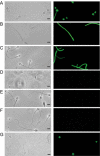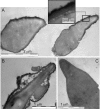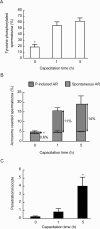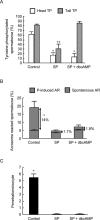Protein tyrosine phosphorylation of the human sperm head during capacitation: immunolocalization and relationship with acquisition of sperm-fertilizing ability
- PMID: 20694019
- PMCID: PMC3739072
- DOI: 10.1038/aja.2010.52
Protein tyrosine phosphorylation of the human sperm head during capacitation: immunolocalization and relationship with acquisition of sperm-fertilizing ability
Abstract
The occurrence of tyrosine phosphorylation (TP) in the sperm head during capacitation has been poorly investigated, and no data exist on the relationship of its dynamics with the acquisition of sperm fertilizing ability. This study localized TP of head proteins in human spermatozoa during capacitation and explored its relationship with acquisition of the ability to display progesterone (P)-stimulated acrosome reactions (ARs) and to penetrate zona-free hamster oocytes. By immunofluorescence, TP immunoreactivity was revealed in the acrosomal region of formaldehyde-fixed/unpermeabilized samples, whereas it was abolished in fixed/permeabilized samples, in which TP immunoreactivity was high in the principal piece. No TP immunoreactivity was detectable in unfixed spermatozoa. Head TP immunoreactivity was localized externally to the acrosome, close to the cytoplasmic membrane, as assessed by transmission electron microscopy. The increase in head TP was an early event during capacitation, occurring within 1 h in capacitating conditions. At this time, the P-stimulated ARs were also increased, whereas egg penetration was as poor as in uncapacitated spermatozoa. At 5 h of capacitation, the extent of neither head TP nor the P-induced ARs were greater than that at 1 h, whereas egg penetration had significantly increased. Seminal plasma inhibited head TP, P-induced ARs and egg penetration. None of these inhibitory effects, unlike those on tail TP, were prevented by the cAMP analogue dbcAMP (N,2-O-dibutyryladenosine 3',5'-cyclic monophosphate). In conclusion, head TP is a subsurface event occurring early during capacitation and is closely related to acquisition of the ability to display P-stimulated ARs, whereas the ability to fuse with oolemma and to decondense is a later capacitation-related event.
Figures




Similar articles
-
Dynamics of the global tyrosine phosphorylation during capacitation and acquisition of the ability to fuse with oocytes in human spermatozoa.Biol Reprod. 2008 Oct;79(4):649-56. doi: 10.1095/biolreprod.108.068254. Epub 2008 Jun 18. Biol Reprod. 2008. PMID: 18562705
-
Tyrosine phosphorylation on capacitated human sperm tail detected by immunofluorescence correlates strongly with sperm-zona pellucida (ZP) binding but not with the ZP-induced acrosome reaction.Hum Reprod. 2006 Apr;21(4):1002-8. doi: 10.1093/humrep/dei435. Epub 2006 Jan 20. Hum Reprod. 2006. PMID: 16428332
-
Inhibition of sperm capacitation and fertilizing capacity by adjudin is mediated by chloride and its channels in humans.Hum Reprod. 2013 Jan;28(1):47-59. doi: 10.1093/humrep/des384. Epub 2012 Oct 31. Hum Reprod. 2013. PMID: 23117128 Free PMC article.
-
Intracellular events and signaling pathways involved in sperm acquisition of fertilizing capacity and acrosome reaction.Front Biosci. 2000 Nov 1;5:E110-23. doi: 10.2741/baldi. Front Biosci. 2000. PMID: 11056077 Review.
-
Role of actin cytoskeleton in mammalian sperm capacitation and the acrosome reaction.Reproduction. 2005 Mar;129(3):263-8. doi: 10.1530/rep.1.00269. Reproduction. 2005. PMID: 15749953 Review.
Cited by
-
The pattern of tyrosine phosphorylation in human sperm in response to binding to zona pellucida or hyaluronic acid.Reprod Sci. 2014 May;21(5):573-81. doi: 10.1177/1933719113504467. Epub 2013 Sep 27. Reprod Sci. 2014. PMID: 24077441 Free PMC article.
-
Mysteries and unsolved problems of mammalian fertilization and related topics.Biol Reprod. 2022 Apr 26;106(4):644-675. doi: 10.1093/biolre/ioac037. Biol Reprod. 2022. PMID: 35292804 Free PMC article. Review.
-
Epididymal and ejaculated sperm differ on their response to the cryopreservation and capacitation processes in mouflon (Ovis musimon).Sci Rep. 2019 Oct 30;9(1):15659. doi: 10.1038/s41598-019-52057-0. Sci Rep. 2019. PMID: 31666633 Free PMC article.
-
Combined Raman and polarization sensitive holographic imaging for a multimodal label-free assessment of human sperm function.Sci Rep. 2019 Mar 18;9(1):4823. doi: 10.1038/s41598-019-41400-0. Sci Rep. 2019. PMID: 30886325 Free PMC article.
-
Acetylproteomic analysis reveals functional implications of lysine acetylation in human spermatozoa (sperm).Mol Cell Proteomics. 2015 Apr;14(4):1009-23. doi: 10.1074/mcp.M114.041384. Epub 2015 Feb 13. Mol Cell Proteomics. 2015. PMID: 25680958 Free PMC article.
References
-
- Yanagimachi R.Mammalian fertilization. In: Knobil E, Neill JD, editors. The Physiology of Reproduction2nd edn. New York: Raven Press; 1994pp189–96.
-
- Visconti PE, Bailey JL, Moore GD, Pan D, Olds-Clarke P, et al. Capacitation of mouse spermatozoa. I. Correlation between the capacitation state and protein tyrosine phosphorylation. Development. 1995;121:1129–37. - PubMed
-
- Tardif S, Dubé C, Chevalier S, Bailey JL. Capacitation is associated with tyrosine phosphorylation and tyrosine kinase-like activity of pig sperm proteins. Biol Reprod. 2001;65:784–92. - PubMed
-
- Baldi E, Luconi M, Bonaccorsi L, Krausz C, Forti G. Human sperm activation during capacitation and acrosome reaction: role of calcium, protein phosphorylation and lipid remodelling pathways. Front Biosci. 1996;1:d189–205. - PubMed
Publication types
MeSH terms
Substances
LinkOut - more resources
Full Text Sources

